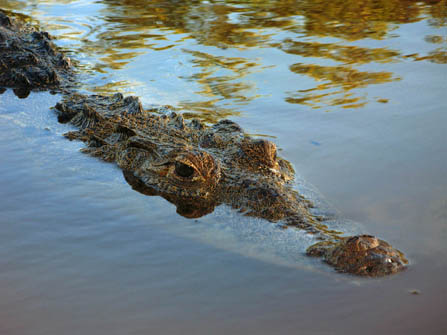Crocodiles overcome threats, some populations suitable for commercialization

With societal effort, the population of American crocodiles in Sinaloa and Nayarit may recover to the point where they could again enter the commercial market, as has happened with the Morelet’s crocodile on the other side of the country. (Photo: Humberto Bahena Basave – Conabio photo archives).
MEXICO, D.F.
Populations of American crocodiles native to the Pacific coast of Latin America are continuing to show an increase in their numbers within Mexico, similar to that already seen with the Mexican crocodiles on the country’s other coast.
This information was revealed at an international workshop titled “Mexican Crocodiles: monitoring of Morelet’s crocodiles 2012-13, and the current status of American crocodiles”. The workshop was organized by Conabio (the National Commission on the Knowledge and Use of Biodiversity) and was held November 25-26 in Mexico City.
Of the 23 species of the world’s crocodilians, three are found in Mexico: the Morelet’s or Mexican crocodile (Crocodylus moreletti), American crocodile (Crocodylus acutus), and the Spectacled or Common Caiman (Caiman crocodilus).
Morelet’s crocodile populations were threatened in the 1970s due to hunting and the unregulated crocodile skin trade.
A number of actions in Mexico have contributed to its recovery, including: a ban on hunting; the establishment of protected natural areas; and the promotion of crocodile hatcheries.
“We need the public to realize that when we in academia, civil society, and the government organize, we can do things very well, as well as any country in the world,” said Dr. José Sarukhán Kermez, national coordinator for Conabio.
According to biologist Hesiquio Benítez Díaz, Director General of International Cooperation and Implementation at Conabio, the populations of the Morelet’s crocodile are now in good shape and show potential for the development of productive and sustainable projects that will both benefit local communities and help with the conservation of the species.
This conclusion is driving an official project that links local communities in different pilot sites in order to make use of eggs that would otherwise not survive in the wild. These eggs would be incubated in nurseries, in order to increase their chance of viability, and the skins harvested from these individuals could be traded on the international market, or the farmed animals could be reintroduced into the wild if necessary.
With U.N. supervision, the International Working Group on Reptile Skins (IWG-RS) from the Responsible Ecosystem Sourcing Platform (RESP) approved the Conabio project on November 19th in London.
The project, besides generating an added value to the products derived from the exploitation of the Mexican crocodile, also promotes the management of the species both in terms of sustainable use of natural capital and benefit to local communities.
The Management and Sustainable Development of Wildlife Program (UMA, for its acronym in Spanish) coordinated by the Secretariat of the Environment and Natural Resources (SEMARNAT, for its acronym in Spanish) backs the plan, especially within those communities located in the municipalities that are targeted by the National Crusade Against Hunger.
About 40 experts on crocodiles attended the meeting, including scientists, business people, non-governmental organizations, and officials from Mexico, Belize and Guatemala, as well as a representative from the International Union for Conservation of Nature’s Crocodile Specialist Group (CSG-IUCN). [ http://iucncsg.org/ ]
The results of the national monitoring program for the Morelet’s crocodile for 2011-2013 were reviewed. During this period, a total of 572 field trips were made, covering 3,437 miles of lakes, rivers, mangroves, and estuaries.
Data from the three field seasons puts the wild population of the Morelet’s crocodile in Mexico at an estimated 79,000 individuals, considered healthy and stable, with good reproduction rates for both juveniles and hatchlings.
The Morelet’s crocodile lives in the watersheds of the Gulf of Mexico, the Yucatan Peninsula and Chiapas, as well as Guatemala and Belize.
Because of the quality of its skin, the species is in high demand by the fashion industry, opening up an opportunity for strictly regulated international trade.
Currently, the Morelet’s crocodile is considered to be in the low risk category. Because of this, in 2010 the species was transferred from Appendix I to Appendix II (less restrictive) of the Convention on International Trade in Endangered Species of Wild Fauna and Flora (CITES), and in 2012 it was removed from the Endangered Species Act (ESA) in the United States, allowing for the exportation of skins to that country.
In contrast, the American crocodile is distributed on the Pacific coast (Sinaloa to Chiapas) and the Yucatan Peninsula in Mexico, and to Peru, Venezuela, Florida and the Carribean.
This species is listed as Subject to Special Protection in the Mexican environmental law known as NOM-059-SEMARNAT-2010, as Vulnerable on the IUCN’s Red List (2012), Endangered on the ESA in the United States (2007), and in Appendix I of CITES (1981), which restricts the international trade of individuals taken from the wild.
Nonetheless, during the workshop, experts concluded that populations of the American crocodile are also recovering in Mexico. They decided to prepare a document for the 27th annual meeting of the CITES Animals Committee, to be held in Veracruz in April 2014, in order to propose that the species’ CITES listing be changed from Appendix I to Appendix II.
They also agreed to develop a proposal of sites where the species would also be included in the permanent monitoring program for Morelet’s crocodile.
At the end of the workshop, Sarakhán said that the work towards conservation and sustainable use of the Mexican crocodiles is based on a “solid scientific, ethically responsible, and socially adequate model for producing a commodity that benefits society and respects nature.”